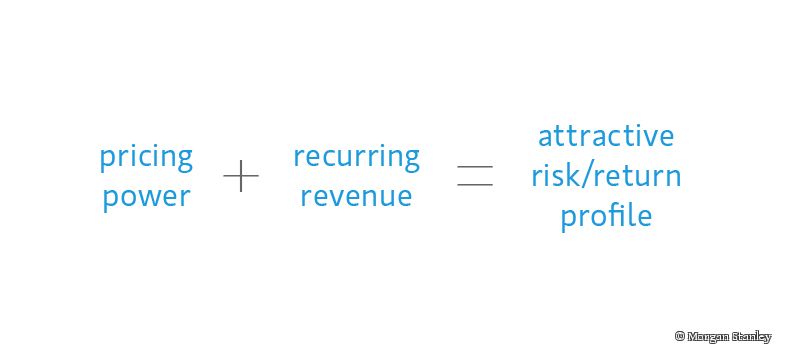
Our Formula for Earnings Resiliency
Is it possible to generate attractive returns in today’s uncertain economic and political environment? We think so.
18.11.2019 | 11:24 Uhr
In our view, “the formula” for successful investing consists of two critical elements: pricing power and recurring revenues. Together, these two factors may yield an asymmetric risk/return profile characterized by strong participation in rising markets with far less participation when markets fall. Before we invest in a company, we seek to affirm that both are present and sustainable over the long term.

Pricing power for sustained profitability
We believe the ability to charge one’s customers incrementally more over time while retaining those customers is one of the keys to sustained profitability. What drives this pricing power? The scarcity of the product may be one factor. More often, though, pricing power derives from the strength of a company’s intangible assets ─ essentially the power of their brands or networks. This is one of the hallmarks of high-quality companies.
Brands signal specific associations to consumers, such as implicit promises of quality or reliability for which the customer is happy to pay during good times and bad. Within the broad consumer staples sector – including categories such as beverages, personal care or beauty ─ continuous innovation also fuels pricing power. Products should ideally evolve with the customer – for example, today’s more sophisticated, informed and sustainably-oriented customer is more likely to look for brand assurances that the company is aware of the environmental and social impact of the manufacture and sale of the product. Companies that understand this are better positioned to grow, build market share and sustain their profitability.
Pricing power can be threatened by irrational industry participants, or a highly competitive market. Investors should be wary of company management which chooses to charge too much for a product (where the customer seeks out alternatives) or too little (where discounting devalues the product and brand). Engaging with companies on capital allocation, how they choose to spend on research & development and advertising & promotion, as well as pricing philosophy all offer useful insights into whether a company’s pricing power is durable.
Recurring revenues for stability
In our view, a more stable top line lends itself to a more stable bottom line. As a team that values predictability of earnings, top line visibility is key. Recurring revenue is the portion of a company's revenue that is expected to continue in the future. Unlike one-off sales or shorter term contracts, these revenues are predictable, stable and can be counted on to occur at regular intervals going forward with a relatively high degree of certainty. Revenues that persist through periods of downturn as well as economic strength are often driven by one or more of these factors:
- Brand loyalty
Repeat business is driven by customers’ affinity or loyalty to a specific good that is consumed routinely, such as household, personal care and beauty products.
- Reliability of supply
Products whose livelihood depends on quality control or those for which experimentation with brand-switching is risky, such as scientific tests and medical products.
- Subscriptions
Subscription-based products such as software and information services are often automatically renewed and less vulnerable to disruption.
- High switching costs
When it is expensive or inconvenient to switch, such as outsourced, non-core services, revenues are stickier.
- Maintenance services
Delivery of services that support existing products, such as software, also tend to endure over time.
Asymmetry: Attractive upside with less of the downside
Each of our team’s Global Franchise, Global Quality and Global Sustain portfolios offer our signature asymmetric return profile – attractive returns over the long term with consistently less participation in down markets.
As we consider history’s longest U.S. bull market, and the global growth, trade tariff escalation or liquidity concerns that might precipitate the end of that, quality companies with sustainable returns on operating capital and strong free cash flows remain our preferred universe. Within that, those that demonstrate pricing power and recurring revenues more clearly offer the formula for outperformance and earnings resilience that today’s market demands.
Past performance is no guarantee of future results. Not all holdings held in the portfolio have or will contribute positively to performance during up or down markets. All investments involve risks including the possible loss or principal.
Risk Considerations
There is no assurance that a portfolio will achieve its investment objective. Portfolios are subject to market risk, which is the possibility that the market value of securities owned by the portfolio will decline. Accordingly, you can lose money investing in this strategy. Please be aware that this strategy may be subject to certain additional risks. Changes in the worldwide economy, consumer spending, competition, demographics and consumer preferences, government regulation and economic conditions may adversely affect global franchise companies and may negatively impact the strategy to a greater extent than if the strategy's assets were invested in a wider variety of companies. In general, equity securities' values also fluctuate in response to activities specific to a company. Stocks of small- and medium-capitalization companies carry special risks, such as limited product lines, markets and financial resources, and greater market volatility than securities of larger, more established companies. Investments in foreign markets entail special risks such as currency, political, economic, and market risks. The risks of investing in emerging market countries are greater than the risks generally associated with investments in foreign developed countries. Non-diversified portfolios often invest in a more limited number of issuers. As such, changes in the financial condition or market value of a single issuer may cause greater volatility. Illiquid securities may be more difficult to sell and value than publicly traded securities (liquidity risk). Derivative instruments may disproportionately increase losses and have a significant impact on performance. They also may be subject to counterparty, liquidity, valuation, correlation and market risks.




Diesen Beitrag teilen: